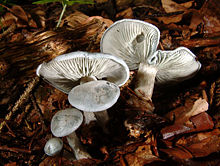- Clitocybe odora
-
Clitocybe odora 
Conservation status FrequentScientific classification Kingdom: Fungi Division: Basidiomycota Class: Agaricomycetes Subclass: Hymenomycetes Order: Agaricales Family: Tricholomataceae Genus: Clitocybe Species: C. odora Binomial name Clitocybe odora
(Fr.) P. Kumm.Synonyms Clitocybe viridis(With.) Gillet
Clitocybe odora Mycological characteristics 
gills on hymenium 
cap is flat 
hymenium is decurrent 
stipe is bare 
spore print is white 
ecology is mycorrhizal 
edibility: unknown Clitocybe odora, also known as the Aniseed toadstool is a blue-green mushroom that grows near deciduous and coniferous trees. They can be found growing in small groups along the side of tree roots. Many mushroom guidebooks suggest that it is edible, but a few expert mushroom hunters insist that young specimens should be avoided as can be confused with Stropharia aeruginosa. The anise odor is due to the presence of p-Anisaldehyde and a small amount of benzaldehyde. [1] This odor can give away the mushroom's presence before it is observed by eye.
Contents
Taxonomy
First described by the French mycologist Jean Baptiste Francois Pierre Bulliard 1742-1793. The specific epithet odora is from the Latin meaning "perfumed".[1]
Description
Young specimens have a light blue texture on the cap which fades to grey in age. The gills and stem are white with no ring.
Full grown specimens have blue-green, flowery, cup-shaped caps; the gills are creamy white. The cap's surface feels rough. The stem is thick, is attached to the gills with no rings, and is textured, with a pale-yellow colour. The younger ones have a bell-shaped cap with a light blue or icy blue colour. The gills and stem are white. It has a strong scent and taste of aniseed, hence its name.
There is a white variety (Clitocybe odora var.alba)Lange which has the same strong odour.
Distribution and habitat
Found in both deciduous, and coniferous woods. It is widespread, and found in the temperate zones. Occurring in Asia, Europe, and North America.On the east coast of America it favours oak, and it is often abundant in the coniferous forests of the Pacific North West.[2]
Edibility
The caps can be dried, and used as a condiment, or used fresh for flavouring.[3] Mushroom hunters should be sure to pick mature ones, mainly because the younger ones can be confused with several similar poisonous ones that grow along with this mushroom. Make sure you observe every part before you put it in your basket. Also, check the stem and cut the cap to see if there are any fly larvae.
References
- ^ Giovanni Pacioni (1993). The Macdonald Encyclopedia of Mushrooms and Toadstools (English version). Little, Brown & Company Ltd. ISBN 0-316- 90625-5.
- ^ David Arora (1986). Mushrooms Demystified. Ten Speed Press. ISBN 0-89815-169-4.
- ^ Richard Maybe (1975). Food For Free, a guide to the edible wild plants of Britain. Fontana / Collins.
External links
Categories:- Clitocybe
- Fungi of Europe
Wikimedia Foundation. 2010.
